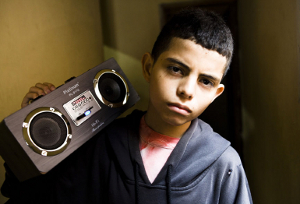Colombia: Mateo chooses Life
 by Tilman Wörtz
by Tilman Wörtz
Photos: Antonia Zenarro
Mateo, the music group Eskalones and the „Elite de Hip-Hop“ use rhymes, dance, and graffiti art to resist the gang culture of Comuna 13, a notorious slum in Medellín, Colombia‘s secondlargest city. Their work is a courageous open-ended experiment.
„Why did you leave without saying goodbye? God, why did my brother have to go? He wasn‘t a bad person!“ Beats and rhymes blast from a tiny portable stereo. The track was produced by Radio, Mateo, Diego, and the other members of the Eskalones. Pick one of their songs at random, and the odds are good it will be about murder, grief, or loss here in Comuna 13.
The song „Rest in Peace“ was written by Chelo, leader of the Eskalones and brother to fourteen-year-old Mateo. Chelo was shot to death in August 2010. He took Mateo to a rap concert in La Floresta park. They were walking side by side, on their left a three-story building, on their right a playground. It was dark. Mateo heard a buzzing sound and saw his brother collapse.
Three more shots. Mateo never saw who did it. The police dropped by Mateo‘s home for half an hour. Asked a few questions about the incident. Crossed it off their list. Just another violent death in Comuna 13. One of nearly two hundred every year.
Comuna 13 is a city within a city, a labyrinth of improvised brick buildings scattered unevenly down the slopes of the Aburra Valley. Alleys and stairways run through the settlement. An estimated one hundred and forty thousand people live here. It is divided by the road to the Pacific port city of Urabá, where over eighty percent of Colombia‘s cocaine leaves the country. Anyone who wants to control the drug trade must control this road and with it Comuna 13. This is not just any Latin American slum. It has become a symbol of the self-reinforcing feedback loop of poverty, drugs and violence in Latin American cities.
The government has turned Comuna 13 into an armed camp. Streets corners are manned by policemen or soldiers, wearing bulletproof vests and carrying automatic weapons. Two army tanks command a central hill.
Eight years ago, there was a major military operation. Shots were fired at random from helicopters into people‘s homes.
Since then the military has occupied Comuna 13. That was when the Elite de Hip-Hop and the music festival „Revolution Without Violence“ were founded.
Instead of preventing violence in Comuna 13, many police officers and soldiers contribute to it by demanding protection money and in some places even controlling the drug trade.
To found an educational and cultural institution and show young people that even in a slum, there are alternatives to becoming a „sicario“: That is the goal of Eskalones, a band that has joined forces with over eighty other rappers, dancers, and graffiti artists, as the „Elite de Hip-Hop.“
„Sicario“ is the local slang term for the drug mafia‘s assassins. In contrast to the U.S., where hip-hop originated, the prevailing style in Comuna 13 is not „gangsta.“
Radio, twenty-four years old, was trained as a barber. He sits at the computer with his shirt off and fiddles for hours with a rhythm track, ultimately mixing piano chords in with the drums and bass. His favorite keys are C major and A minor. His name is tattooed on his back in Gothic letters. Radio. His father was a popular radio DJ. The tracks will become part of a CD by Mateo in memory of his brother Chelo.
Radio can barely produce enough beats to keep up. Mateo has been writing a lot lately. So far five tracks have been completed. Mateo warms up his vocal cords in the sound booth. His blue and white sweatshirt, much too large and with a hood added by his godmother Claudia, hangs to his knees. „Let‘s just admit I‘m the coolest,“ he declares before launching into his lyrics: „Don‘t believe I‘m an unprotected kid, don‘t drag me through the dirt / I say no to war / I wouldn‘t hurt a fly, I use words instead of weapons / I‘m a rapper like my brother, just a rooster in the Comuna who wants to crow in peace …“
„We‘re not against anyone,“ Radio says in soothing tones as he breaths out smoke from a joint. Being against anyone is dangerous in Comuna 13. Radio hopes to use his music to break through the vicious cycle of violence and retribution. He has retreated into the Eskalones‘ recording studio. The room is less than seven square feet but it holds a small sofa, two plastic chairs, a table with a mixing board, computer, and keyboard, and a sound booth for the microphone.
The Eskalones spend nearly all day every day in the studio. A hip-hop crew on the run in its own city.
Only a few days after Chelo‘s murder, a motorcyclist waited for Mateo after school and followed him home. He fled to safety as quickly as he could. Radio has received threats on his Facebook page: „It would be better if you disappear. We don‘t want you.“ The Eskalones went into hiding with Diego and his mother, Claudia. The boys call her „la madrina,“ godmother. „I like having them around,“ she says.
Claudia‘s apartment can offer sanctuary to the Eskalones because she lives in a section of Comuna 13 controlled by the San Sebastian clan. It was most likely the rival Valencianos who shot Chelo. An invisible boundary between the two clans San Sebastian and Valenciano follows the line of the aerial cable car that spans Comuna 13.
But the border is not hard and fast. There are isolated enclaves, shootouts between one hill and another, house-to-house combat at close quarters. Children, women, and the elderly can move freely. But for younger men, border violations may be deadly: They are assumed to be spies or even killers from the enemy gang. Every male teenager in Comuna 13 is a potential gang member for one side and thus a potential enemy of the other. And if he wasn‘t an enemy yesterday, he could turn into one today.
The Elite de Hip-Hop gathers in a two-story building belonging to the Christian youth organization YMCA, near the San Javier metro station. Eight young men, wearing hip-hop- style clothing, wait patiently in the common room for Radio to show up. He is the chairman of the department of MC Training at the school they are setting up.
MC, originally short for master of ceremonies, is what rappers call themselves. The MCs present an outline of their curriculum. Rhythm theory, body language, breath control, verbal expression, the history of rap. Skills the Elite taught themselves on the street are to be given systematic form. Several members already work occasionally as instructors.
A half dozen B-boys practice break dancing every day in the entrance to the library. The older ones teach the younger ones. Dance is one of four areas of study offered by the hip- hop academy, along with vocals, graphic art and music production.
Santi woke up from his coma two weeks ago. It began when he took a bullet in the head. He seems apathetic, wrapped up in a blanket, his voice a whisper.
His mother asked a friend, the graffiti artist „El Perro,“ the dog, to give Santi lessons. She believes that learning the history of graffiti might awaken Santi to new life. Such experiences make young men like El Perro more self-confident. Many teach not just a few but hundreds of students, and sometimes they are able to turn their passion into a job and earn enough money to live on.
Meetings of the Elite de Hip-Hop are accompanied by lively discussions. News of their successes has spread. Increasingly, the neighborhood‘s hip-hoppers want to join up. The Elite has to decide who can become a member and who will receive additional training.
The city government in Medellín pays each hip-hop instructor a stipend of around two hundred euros per month for three months, as much as the minimum wage, and invites them to festivals or to speak to school classrooms on such topics as nonviolence and environmental protection.
It‘s a lot of money and respect for people who had been regarded as losers. If the young people succeed in organizing and managing the school, the city administration has promised to extend their stipends.
Radio sits thoughtfully at the computer in the tiny recording studio. He just returned home to his godmother Claudia. „They shot somebody in front of the metro station,“ Diego says. „He was sitting in the car, a motorcycle drove by, and boom, boom, boom.“ Nobody answers.
„We are responsible for our actions / The adults are at war and the children harvest grief / The eyes of God cry silently when they see the money flowing into weapons and drugs.“
Radio‘s rhythmic chanting drones through the schoolyard. The students know his rhymes by heart. „Are you ready for Mateo?“ Radio asks. The kids shriek, „Yes!“ Mateo is their own age, the Justin Bieber of Comuna 13. Everyone knows him. To become more like him, they are happy to fill out registration forms for the Elite de Hip-Hop.
Around a dozen rappers, dancers and graffiti artists from the Elite are on a marketing tour to win the support of schools in Comuna 13. The mood is relaxed.
On the sports field at their first stop they assemble a sound system and roll out the dance floor. Drumbeats pulse through the schoolyard.
The performance is repeated at five additional schools. In the end, four hundred and twenty pupils have signed up for hiphop training.
In the evening the Elite celebrate in a house near the prison. It is relatively safe here.
The members of Eskalones say that they repeatedly encounter sicarios at their live performances. Many of them are people they grew up with. Around one o‘clock in the morning, a young man with full, bowed lips and his hair combed back appears.
He asks not to be photographed. He stays on the edges of the festivities. Only a few people speak with him, but everyone knows him. „La Boca,“ the mouth, is a high-ranking sicario. „Number four of eighty,“ they say. Someone like him has killed many times and is lucky to be alive himself. He responds to questions with a soft voice, hesitating to make eye contact. But the partygoers are in agreement that when he goes on assignment, his shyness disappears.
La Boca takes us along to his gang‘s safe house. It is quieter there. Eight sicarios live here, two to a room. Two days ago, the police stormed the house and arrested the leader, „El Negro.“
But they did not confiscate any of the weapons they saw lying around. The police know what La Boca does. Nevertheless, he is involved in a project to reintegrate paramilitary and guerrilla fighters for which he receives money every month from the government. The program is called „Fuerza Joven“, Youth Power, a hopeless attempt to end the war in the slums.
Sicarios and the hip-hoppers of the Elite come across each other in daily life. But the hip-hoppers‘ conversations are about more than drugs, money and women.
They talk about hip-hop, the elegant powerline of the graffiti slogan on a nearby stadium grandstand, proper ways of dancing and rhyming, plans for building up the hip-hop academy, the next festival. Things that over the years have immunized Mateo and his friends against „the bad life,“ though the protection is fleeting and booster shots are required again and again. The Eskalones have not gone underground.
They are working with the only weapons they have.
Rhymes.


